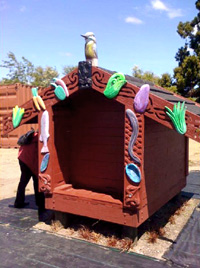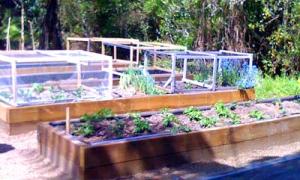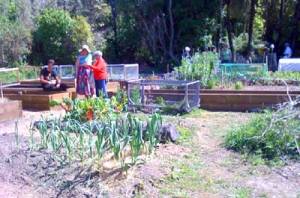MANA Rotorua are always looking for community projects we can actively support, and when the Rotorua District Council recently arranged an all-day visit to five community gardens MANA member Maree Conaglen went along.
Here’s her story.
 A special highlight was the community garden at Mataikotare (Waiohewa) Marae. Visitors were welcomed by a powhiri from local iwi and kaiwhakahaere Bernie Hornfeck, our Mana Rotorua kaumatua and veteran gardener who last year grew a record 1kg parsnip.
A special highlight was the community garden at Mataikotare (Waiohewa) Marae. Visitors were welcomed by a powhiri from local iwi and kaiwhakahaere Bernie Hornfeck, our Mana Rotorua kaumatua and veteran gardener who last year grew a record 1kg parsnip.
The visitors were given a tasty lunch of club sandwiches and cake before visiting the marae community gardens. Bernie told the group the garden had been operating successfully for four years, and he also spoke of the importance of growing your own vegetables not just to save money, but also because most kai is no longer grown locally. If oil supplies which are always dependent on war-torn countries in the Middle East unexpectedly fail, supermarkets would be empty in five days but it would be five months before starving families without a garden could grow enough food for their own needs, so a good vegetable garden is a wise precaution.
 Bernie impressed the visitors with his knowledge and expertise in raising tipu, the kumara shoots from which plants are grown. Kumara need warmth to grow well and most ancient marae gardens were on warm sunny slopes, so Bernie grows tipu by planting a fully grown kumara or one-half cut lengthwise in the warm thermal ground at Ohinemutu, where there is no frost. From these parent kumara the tipu grow and are ready to plant out in the spring. Plants are grown in carefully mounded rows with black polythene used to prevent weeds as well as keep the soil warm.
Bernie impressed the visitors with his knowledge and expertise in raising tipu, the kumara shoots from which plants are grown. Kumara need warmth to grow well and most ancient marae gardens were on warm sunny slopes, so Bernie grows tipu by planting a fully grown kumara or one-half cut lengthwise in the warm thermal ground at Ohinemutu, where there is no frost. From these parent kumara the tipu grow and are ready to plant out in the spring. Plants are grown in carefully mounded rows with black polythene used to prevent weeds as well as keep the soil warm.
 Bernie also demonstrated the correct way to place kumara so the plant always faces north towards the sun. The visiting gardeners were given tipu to take home for their own gardens and they were also shown the garden’s beautifully constructed pataka still used for food storage.
Bernie also demonstrated the correct way to place kumara so the plant always faces north towards the sun. The visiting gardeners were given tipu to take home for their own gardens and they were also shown the garden’s beautifully constructed pataka still used for food storage.
Tradition says that kumara were brought to Aotearoa from Hawaiiki about 400 years ago after an even longer journey from South America centuries earlier, and are not only a long-established staple food but also a taonga to be treated with respect and reverence.
 A big thank you and mihi to Rotorua District Council and local iwi, Mataikotare marae and Bernie, and we hope everyone who visits these maara kai will learn more about how to develop their own.
A big thank you and mihi to Rotorua District Council and local iwi, Mataikotare marae and Bernie, and we hope everyone who visits these maara kai will learn more about how to develop their own.

